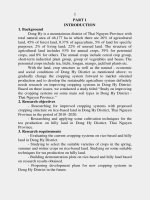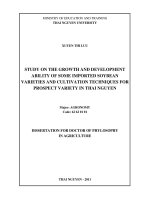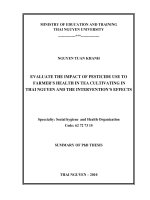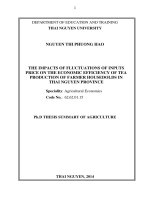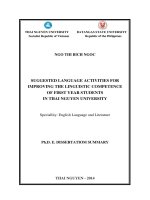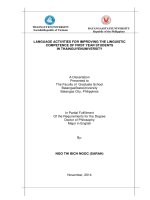IM PROVING THE COMPETITIVENESS 0F BLACK TEA PRODUCING ENTERPRISES IN THAI NGUYEN PROVINCE
Bạn đang xem bản rút gọn của tài liệu. Xem và tải ngay bản đầy đủ của tài liệu tại đây (906.06 KB, 94 trang )
IM PROVING THE COMPETITIVENESS 0F BLACK
TEA PRODUCING ENTERPRISES IN THAI NGUYEN PROVINCE
A Dissertation
Presented to the
Faculty of Graduate School of
Southern Luzon State University, Philippines and
Thai Nguyen University, S.R. Vietnam
In Partial Fulfillment
of the Requirements for the Degree
Doctor in Business Administration
TRAN THI HUYEN (MARY)
August 2013
THAI NGUYEN UNIVERSITY
Socialist Republic of Vietnam
SOUTHERN LUZON STATE
UNIVERSITY
Republic of the Philippines
IMPROVING THE COMPETITIVENESS OF BLACK
TEA PRODUCING ENTERPRISES IN THAI NGUYEN
PROVINCE
DISSERTATION
Advisor : Dr. NGUYỄN KHÁNH DOANH
Name of Student : TRẦN THỊ HUYỀN
English Name : Mary
Date of Birth : 09/11/1979
Course : SLSU-DBA I
Thai Nguyen, May 2013
i
Title
IMPROVING COMPETITIVENESS OF BLACK TEA
PRODUCING ENTERPRISES IN THAI NGUYEN
PROVINCE
A Thesis
PRESENTED TO THE FACULTY OF THE
GRADUATE SCHOOL SOUTHERN LUZON
STATE UNIVERSITY IN COLLABORATION
WITH THAI NGUYEN UNIVERSITY
In Partial Fulfillment of the Requirement for the Degree of Doctor in Business
Administration
TRAN THI HUYEN- 2013
ii
ACKNOWLEDGMENT
To complete the thesis, I have received the help of Thai Nguyen University,
International Training Center-ITC, University of Southern Luzon - PHILIPPINES, Thai
Nguyen College of Economics and Finance, the teachers, scientists, Provincial People's
Committee of Thai Nguyen, Department of Agriculture and Rural Development of Phu Tho
Province, Department of Agriculture and Rural Development of Tuyen Quang Province,
Thai Nguyen Department of Technology, Department of Planning and Investment of Thai
Nguyen, The small and medium tea enterprises in the provinces of Thai Nguyen, Phu Tho,
Tuyen Quang and the help of instructors. I would like to express my sincere thanks to the
organizations and the individuals who helped me during this research.
In particular, I would like to sincerely thank Dr. Nguyen Khanh Doanh has
dedicatedly helped me to complete this thesis.
I am deeply and forever indebted to my family for their love, support and
encouragement throughout my entire life. I would like to thank my husband Duong The Cao,
who has provided a tremendous amount of love and support during my research. On the final
note with love is for my children.
So much for objective and subjective reasons, the thesis has a lot of shortcomings; I
look forward to receiving the construction ideas from scientists, teachers and colleagues.
Sincerely
Thai Nguyen,……………………………
The thesis‟s author
Mary
iii
ABSTRACT
CHAPTER I: THE PROBLEM AND ITS SETTING 1
Introduction 1
Background of the study 2
Statement of the problem 4
Research Questions 5
Objectives of the study 5
The overall objectives 5
Specific Objectives 6
Hypotheses of the study 6
Significance of the study 7
Scope and limitations of the study 7
Definition of terms 8
CHAPTER II: REVIEW OF RELATED LITERATURE AND STUDIES 10
2.1. The conceptS of competition 10
2.2. The conceptS of competitiveness 12
2.3. System of criteria for assessing the competitiveness of enterprises 15
2.4. The basic contents when researching the competitiveness of enterprises 17
2.4.1. Competitiveness of products 17
2.4.2. The market share of the enterprise 17
2.4.3. Business performance 17
2.4.4. The productivity of production factors 17
2.4.5. The ability to link and cooperate of enterprises 18
2.4.6. The ability to attract the resources 18
2.5. The factors affecting the competitiveness of enterprises 18
iv
2.5.1. Economy 18
2.5.2. Interest rate on loans 18
2.5.3. Science and technology 18
2.5.4. The subplier 19
2.5.5. Threat of substitute products or services 19
2.5.6. Threat of new entrants 19
2.5.7. Level of organization and human resources 20
2.5.8. Financial capacity of enterprise 20
2.5.9 Marketing capacity of enterprise 20
2.6. Related literatures and studies 20
2.7. Conceptual framework 23
CHAPTER III: RESEARCH METHODOLOGY 25
3.1. Study area selection 25
3.2. Approach methods 25
3.3. Methods of data processing 27
3.4. Other methods 27
3.4.1. The descriptive statistical methods 27
3.4.2. Comparative method 27
3.4.3 Method of experts 28
3.4.4. Method of SWOT analysis 28
CHPATER IV: PRESENTATION ANALYSIS AND INTERPRETATION OF DATA 29
4.1. Status of competitiveness of black tea producing enterprises in Thai Nguyen province 29
4.1.1. Competitiveness of black tea products in Thai Nguyen‟s tea enterprises 29
4.1.2. The efficiency of production and business of black tea producing enterprises in Thai Nguyen 40
4.1.3. The productivity of the factors 42
v
4.1.4. The capacity to attract financial resources of enterprises producing black tea in Thai
Nguyen 45
4.1.5. Ability to cooperate and work of black tea businesses in Thai Nguyen. 46
4.2. Factors affecting the competitiveness of black tea producing enterprises in Thai Nguyen
province 46
4.2.1. Economy factors 46
4.2.2. Interest on loans 47
4.2.3. Political factors and legal 48
4.2.4. Elements of science and technology 48
4.2.5. The threat of substitute products and services 48
4.2.6. Industry competitors 49
4.2.7. The organizational level and management of human resources 50
4.2.8. Facilities and technology in the business of black tea in Thai Nguyen 52
4.2.9. Marketing Capacity 52
4.2.10. Financial resources 53
4.3. The strengths, weaknesses, opportunities and threats of black tea producing enterprises
in Thai Nguyen 53
4.3.1. The strengths 53
4.3.2. The weaknesses 54
4.3.3. The opportunities 54
4.3.4. Threats 55
CHAPTER V: CONCLUSION AND THE PROPOSED SOLUTION 56
5.1. Conclusions 56
5.1.1. Through the study we draw the following conclusions 56
5.1.2. Capacity assessment and competitive factors affecting the competitiveness of
vi
enterprises producing black tea in Thai Nguyen we found: 57
5.2. Some solutions to improve the competitiveness of balck tea producing enterprises in
Thai Nguyen province 58
5.2.1. Viewpoints 58
5.2.2. Orientation 59
5.2.3. Some solutions to enhance competitiveness for enterprises producing black tea 59
5.2.4. Solutions for state policy 64
5.3. Recommendations 64
5.3.1. For State 64
5.3.2. For agencies, Thai Nguyen provincial government 64
5.3.3. For processing business, the business of black tea 65
BIBLIOGRAPHY 66
APPENDIX 1 69
APPENDIX 2 82
vii
LIST OF TABLES
Table 3.1: The number of sample divided by form of ownership 26
Table 3.2: The number of sample divided by capital scale 26
Table 4.1. Customers‟ reviews of black tea products‟ quality of in Thai
Nguyen‟s tea enterprises 32
Table 4.2. Customer reviews on the form of black tea products‟ packaging 33
Table 4.3. Some product categories in the black tea producing enterprises 34
Table 4.4. Products‟ brand in black tea producing enterprises in Thai Nguyen 34
Table 4.5. Production costs and profits of black tea producing enterprises in
Thai Nguyen according to the forms of ownership 35
Table 4.6. Production costs and profits of black tea producing enterprises in
Thai Nguyen according to the capital scale 36
Table 4.7. The forms of advertising that black tea producing enterprises
applied in 2012 38
Table 4.8. The forms of advertising that black tea producing enterprises applied 39
Table 4.9. The efficiency of production and business of black tea producing
enterprises in Thai Nguyen according to the capital ownership 40
Table 4.10. The efficiency of production and business of black tea producing
enterprises in Thai Nguyen according to the capital scale 41
Table 4.11. Margin / revenue of black tea producing enterprises in Thai Nguyen
compared to black tea producing enterprises in Phu Tho and
Tuyen Quang according to the forms of ownership in 2012 42
viii
Table 4.12. The productivity of capital and assets of the black tea
producing enterprises in Thai Nguyen 43
Table 4.13. Capital turnover ratio of black tea producing enterprises in
some provinces and the forms of ownership 44
Table 4.14. Income affects consumption of black tea products in 2012 47
Table 4.15: Qualifications of Enterprise leaders in the production of black
tea in Thai Nguyen 50
Table 4.16. Qualifications of workers in enterprise producing black tea in
Thai Nguyen Province 51
ix
LITS OF FIGURES
Figure 1: Model of five competitive forces 11
Figure 2.1. Analytical framework of competitiveness of black tea producing enterprises
in Thai Nguyen Province 24
Firgues 4.1: The process of black tea processing 31
Figure 4.2. System of a distribution channel of some companies and processing facilities 37
1
CHAPTER I
THE PROBLEM AND ITS SETTING
Introduction
Tea is the perennial plant that has an important role in our social economy, Drinking
tea has long become a necessity in everyday life, and a habit brought the culture of Vietnam.
Tea is also an important export of our agriculture. Currently, 39 countries all over the world
have grown and processed tea, Vietnam has been ranked fifth in area and eighth in
production.
For years, tea tree has held an important position in the socio-economic development
strategy of Thai Nguyen province. Tea tree is the key to poverty reduction in agriculture,
rural development. With an area of 20 thousand hectares under tea business, farmers' average
annual harvest was 100 thousand tons, over 300 billion. Besides, there are more than 75
businesses, factories, tea processing facilities with a capacity of 10-50 tones of fresh
buds/day, dealing with the employment problem for thousands of agricultural workers. Tea
productions in recent years have contributed significantly to poverty reduction and elevate
the poor countryside. That is something one can hardly deny.
Thai Nguyen Province is known as the "capital" of the tea, where there are hundreds
of years old tea areas. Thai Nguyen Tea with the biological characteristics is superior to the
other varieties: The ability to grow, thriving, high quality tea, fragrance, the flowing nutrient.
Thai Nguyen tea plants produce high-quality tea leaves. Annual income from tea
plants accounts for over 60% of total income from farming activities. The activities of
production, processing, consumption create a lot of jobs; contribute to raising incomes and
living standards for the people.
In recent years, the market has appeared much more tea products with designs and
beautiful packaging, rich category, high quality. Consumer tastes are shifting sharply to the high-
2
quality products, products meet food safety. Thus, to survive and grow, black tea products also
need to shift and develop according to the trend of the times.
Therefore, studies to evaluate the situation, identify the factors that influence it,
finding solutions to improve the competitiveness of black tea in small and medium
enterprises in Thai Nguyen province is an urgent requirement that have scientific and
practical significance. Because of those reasons, I chose the thesis: “IMPROVING THE
COMPETITIVENESS OF BLACK TEA PRODUCING ENTERPRISES IN THAI NGUYEN
PROVINCE”.
Background of the study
Competition has a great and important role for the development of the economy in
general, and each small and medium enterprise in particular. Any economy needs to
maintain the competition. From the point of view of social benefits, competition is one of the
forms that the State used to be antitrust, create opportunities for consumers to choose the
products with good quality and cheap price. From the standpoint of enterprises, competition
will be favorable conditions in order for each enterprise to assert its position in the market.
Competition forces enterprises to produce and supply the products, goods and services that
the market needs to meet the increasingly diverse demands of customers.
Currently, in the economy of Thai Nguyen Province, small and medium enterprises
account for over 70% of the total number of registered enterprises, generate about 50% of
GDP and over 80% jobs for workers. However, small and medium enterprises are facing a
lot of problems affecting the efficiency, competitiveness, such as small capital, weak access
to capital, backward equipment and technology, quality of human resources, the weak
management. Due to small size, small and medium enterprises are facing difficulties and
challenges in competition both inside and outside the country, especially in the context of
international integration and global markets controlled by multinational companies and
transnational companies.
3
In the context of the general difficulties of the economy, the small and medium tea
enterprises in Thai Nguyen Province is considered to be the most affected. The enhancement
of competitiveness becomes a vital question of the enterprises. Over the years, Tea tree has
always been identified as a key economic crop for tea growing districts. Producing and
exporting tea increasingly play an important role and become one of the key economic
sectors of the province, with 80% of the province's tea production for export. Earnings from
tea exports have contributed to socio-economic development of the province.
However, the fact that the province's tea exports have not really had prestige, low
quality compared to other countries in the region and the world, even in the country. The
underlying cause of this problem lies right in the beginning stages of the production process,
from the building the material region, breeding, processing technology Most processing
enterprises and exporters of tea are difficult to input source, fluctuation of prices,
fragmentary production, even facing the risk of market loss. Although the majority of
produced tea of the province is for export but mainly in the form of raw materials, the tea‟s
brand has not been positioned, therefore the income of tea growers and producers are not
high. Producing and exporting tea has not promoted the potentials and strengths to be
confirmed as the key economic sectors of the province. The domestic market is fiercely
competed by the famous tea companies in the world such as Lipton, Dilmah, and Qualitea.
The market share of tea industry is shrunk. Numerous companies are on the brink of
bankruptcy. Therefore, at this time, there should be an overview of the investment in the
development process of the tea industry, but first of all is the investment in the development
process of raw tea. Analyze the causes of these problems so that put forward the solutions to
have the most effective investment in order for the tea industry to overcome the crisis.
Enhancing the competitiveness for tea products like a prediction problem to look back and
analyze those data in the past then give the solutions for future. Assessing the competitive
4
situation of tea products, recognize the strengths and weaknesses the give the right directions
in the future.
Statement of the problem
In the face of requirements of economic development, particularly in the process of
international economic integration today, to survive and grow strongly, tea industry must
have the appropriate solutions. In recent years, the black tea producing enterprises in Thai
Nguyen province encounter a lot of difficulties, black tea products of the province faced 3
problems as: Export markets to countries in the Middle East were disrupted by political
instability. The Russian market is affected by imports from other teas. Unfavorable weather
affects tea production. From 3 reasons leading to earnings from tea reduced, some plants
temporarily closed. Before this situation, how to help the black tea producing enterprises in
Thai Nguyen province have good development to ensure requirements: quantity, quality,
competitive price, packaging, market share, revenue, profit. So the research aims to improve
the competitiveness of the black tea producing enterprises in Thai Nguyen province as
observed by businesses and customers. Specifically, it seeks answers to the following
questions:
- The position of the black tea producing enterprises in Thai Nguyen province in the
markets today?
+ Market share
+ Quality
+ Price
+ Revenue
+ Profit
- Competitive advantages of black tea products as observed by the enterprises?
+ Market share
+ Quality
5
+ Price
+ Revenue
+ Profit
- Competitive advantages of the black tea producing enterprises in Thai Nguyen
province as observed by customers?
+ Market share
+ Quality
+ Price
+ Revenue
+ Profit
- Are there significant differences between the observation of enterprises and
customers about the competitive advantage?
- What‟re the factors affecting the implementation of competitive advantage?
- The solutions can be introduced to improve the competitiveness of the black tea
producing enterprises in Thai Nguyen province to meet consumer demand?
Research Questions
1. How to increase the competitiveness of black tea products of small and medium
enterprises in Thai Nguyen?
2. What factors are to consider the competitive advantage for black tea products in Thai
Nguyen province?
3. How to improve the competitive advantage of the black tea producing enterprises of Thai
Nguyen province in today's market?
Objectives of the study
The overall objectives
Based on studying the real situation, factors affecting the competitiveness of black tea
producing enterprises, and then propose the direction and solutions to improve the competitiveness of
black tea producing enterprises in Thai Nguyen province.
6
Specific Objectives
Systemize the theoretical and practical basis for improving competitiveness of
enterprises in general, and particularly for black tea producing enterprises in Thai Nguyen
province.
Assess the situation; analyze the causes and factors affecting the competitiveness
of black tea producing enterprises in Thai Nguyen province.
Propose strategies and solutions to enhance the competitiveness of black tea
producing enterprises in Thai Nguyen province.
Hypotheses of the study
Based on the theory discussed in Chapter 2 and the research objectives of the thesis,
the following hypotheses were tested in the study:
- There are no significant differences in the observation of the enterprises that have
different competitive advantage of black tea:
+ Prices of products
+ Product innovation
+Products‟ quality
+ Packaging and designs of products
+ Services for products
- There are no significant differences between the observation of enterprise and the
employees about the competitive advantages of black tea product:
+ Prices of products
+ Product innovation
+Products‟ quality
+ Packaging and designs of products
+ Services for products
7
Significance of the study
This study will help small and medium tea enterprises in Thai Nguyen assess aspects
of competition to determine the strengths and weaknesses to enhance their competitiveness.
Furthermore, this study will help tea enterprises improve their competitiveness such as:
market expansion, brand building and maximizing profits.
- For tea industry: This study will help the tea industry to develop its products, from
increasing the area to the production and consumption, thereby increasing the state budget,
creating more jobs for local people and sustainable development.
- For labor: This study will help the labor to increase their income, have stable life
and many jobs.
- For customers: This study will help the customers gain access the products
conveniently and satisfy the demand.
- For the researcher: This study will help to complete the DBA thesis, In addition,
there is a document for the teaching of the author.
- For community: When enterprises do business effectively, they will contribute to
the state budget and social welfare.
- The thesis assessed the current situation of black tea products in small and medium
enterprises, determine its position in the export market. Determine how to have efficiency in
competition of the black tea products in small and medium enterprises. Introduce a new
competitive method for tea enterprises to improve their competitive advantages in the market.
Scope and limitations of the study
* Time: From 2010 to 2012
* Space: Gather information about the black tea producing enterprises in Thai
Nguyen Province and some black tea producing enterprises in the two provinces of Phu Tho
and Tuyen Quang
8
* Content: Study the basics:
- Focusing on a number of issues about the competitiveness of black tea producing
enterprises
- The study analyzes the situation of the competitiveness of black tea producing
enterprises in Thai Nguyen province.
- Propose the solutions to improve the competitiveness for black tea producing
enterprises.
Definition of terms
Competitiveness: is the ability to gain market share against competitors in the
market, including the ability to regain one or the entire market share of competitors.
Competitive factors: are the ones related to the competitiveness of products and
businesses when they compete with rivals.
Competition index is the index used to assess the competitive position of the
business compared with rivals.
The decisive factor is the factor affecting the decision of the competitiveness of tea
products.
Need: is the demand for products in the market.
The relevant factors are the ones that affect the performance of tea products such as
input, support activities.
Customer is a person or an organization or an enterprise willing to buy products to
satisfy those needs.
Workers are those perform work regularly according to administrator‟s orders. They
receive salaries and benefits according to the labor contract.
Small and Medium Enterprises are the ones that have small-scale in capital and
labor, revenue or including 3 above factors.
9
Geographical location is the place where the enterprises or customers stay.
Sales area is the one where the tea products are on display, distributed.
Substitute products and services are the ones offered by the enterprises to satisfy
the customer's needs.
10
CHAPTER II
REVIEW OF RELATED LITERATURE AND STUDIES
2.1. The conceptS of competition
In the development of market economy in Vietnam today, the concepts related to
competitiveness are very different.
In Marx‟s opinion: "Competition is the bitter struggle and rivalry among capitalists
to grab the favorable conditions of production and consumption for the excess profits".
The other point of view: "Competition is the striving for quality of products and
services of your business that is better than other businesses" (according to the authors of
the book "Enhancing competitiveness and protection of domestic producers").
According to the economic politics: "Competition is the mutual annexation among
opponents to win the market and customers for their business"
According to the Vietnam Encyclopedia: "Competition is the rivalry among goods
producers, traders, the businessmen in the market economy, driven by supply-demand
relationship, to gain the conditions of production, consumption and most profitable market"
In the opinion of Marketing, competition is defined: "The competition is making
tactics and strategies in line with business potential, good handling strategies, tactics of
opponents, win advantages in trade in goods and services to maximize of profits” (Dr.
Nguyen Nguyen Cu, Agricultural Marketing syllabus).
In The Vietnamese dictionary editted by Nguyen Như Y (Page 61) in 1998:
"Competition is the competition between individuals and collectives that have the same
function to win a victory”. This is true for various activities in society, the individual or
group with the same function no matter what position, the competition are to do a better
job, effective and better quality. If there is a rivalry, the enterprises will develop better and
offer better ways to meet customer‟s needs.
11
In The Vietnamese dictionary editted by National Assembly in 1995 (page 36):
“Competition is the competition among the producers of goods, merchants, traders in the
market economy driven by supply and demand relationship in order to gain the conditions
of production, consumption and most profitable market". According to this definition, the
competition among enterprises, countries became more equal.
To understand the most general, we can express as follows:
Competion is one of the characteristics basic of market economy, the development capacity
of market economy. Competition is the survival of enterprises. Competition can also be the rivalry
among businesses for a factor or customers to improve their position in the market, to achieve
specific goals: profit, sales or market share…
Michael Porter's model of five competitive forces
In the market economy, any business that operates in the market must be under a
certain competitive pressure that depends on five basic competitive forces, represented by the
following model:
Figure 1: Model of five competitive forces
Michael Porter's model of five competitive forces is a model by many analysts use to assess
the competitiveness of a business or an industry
12
2.2. The conceptS of competitiveness
Since the 1980s, the term "competitiveness" was widely used by researchers and
businessmen. Some researchers suggested that, those terms are used the same at different
levels of competition and and interchangeably. Some other researchers argued that, those
terms are not identical but different and each researcher offered a different perspective on
them. Therefore, to give a correct and unique definition, reflecting each term is difficult to
implement, with the agreement of the researchers absolutely (page 60). During the study, the
authors found some of the following concepts:
Competitiveness is one of the concepts that have not had the agreement. When
talking about the competitiveness, we have to mention the subject of competition, so there is
no concept of competitiveness in general, that the concept of competitiveness is applied to
both levels: Macro level (competitiveness of a country or region) and micro level
(competitiveness of enterprises and the competitiveness of the product).
At the micro level, there have a concept: “The enterprises with competitiveness are
those which achieve the progress higher than the average of quality of goods and services, or
have the ability to cut down relative costs to allow them to increase profits and market share”
(Michael Dunford, Helen Louri, 1998).
The author Michael Porter also acknowledged, there can not give an absolute concept
of competitiveness. In his opinion, “To compete successfully, the enterprises must have
competitive advantages in the form of either low production costs or product differentiation”
(Michael Porter, 1990).
* National competitiveness
According to World Economic Forum, competitiveness of a country is the ability to
achieve and maintain high growth rates on the basis of policies, institutions and other
economic characteristics.
13
According to the U.S Board of Industrial Competitiveness (page 28), “Competition
for a country is the level at which under the market conditions of freedom and fairness, can
produce the goods and services to meet the demands of the international market,
simultaneously maintain and raise the real incomes of its people"
Global Competitiveness Report gave the definition of national competition: “The
ability of that country achieves rapid and sustainable results of living standards. That is to
achieve the high rate of economic growth calculated d by the change of gross domestic
product per capita over time”. With this definition, a nation's competitiveness is determined
on the basis of stable and better living standards, higher earnings of people.
Some other economists suggested the concept of competitiveness of countries based
on labor productivity, Porter said that: “The most meaningful concept of national
competitiveness is labor productivity” (Michael Porter, 1990, page 79). Porter's theory was
to enhance the role of enterprises in national competition. A country with high
competitiveness when enterprises in that country have competitive strength and that power is
higher labor productivity. In his opinion, the basic elements such as: infrastructure, skilled
workers, competitive pressure, law, technology. These factors have a major role to create the
competitive environment; the competitive environment increases the labor productivity of
the enterprises.
Fagerberg defines competitiveness of a country is “the ability of a country to realize the
purpose of centralized economic policy, especially for the growth of income and employment
without meeting the difficulties in balance of payments” (Nguyen Vinh Thanh, 2005)”.
* Competitiveness of Enterprises
In 1998, UK‟s Ministry of Trade and Industry defined: “For enterprises,
competitiveness is the ability to produce the right product, determine the right price at the
right time” (Nguyen Huu Thang, 2008).
14
In Aldington Report‟s opinion (1985): “The enterprise has competitiveness when it can
produce products and services with unsurpassed quality and lower prices than competitors in
the domestic and international. Competitiveness means to achieve long-term interests of the
enterprises and the ability to guarantee income for workers and enterprise‟s owners".
In view of M.Porter, in the market economy, any industries and enterprises are under
competitive pressure during operation. The competitiveness of enterprises depends on 5
factors: Bargaining power of suppliers; threat of new entrants; threat of substitute products
and services; the bargaining power of buyers; industry competitors.
There are a lot of concepts of competitiveness of enterprises, as follows:
- Competitiveness of enterprises is the ability to maintain and expand market share,
the profitability of the enterprises. According to this concept, competitiveness is the ability
to consume goods and services compared to the competitors and the profitability of the
enterprises. These concepts can be found in the work of Mehra (1998), Ramasamy (1995),
Bruckley (1991), Schealbach (1989) or in the country as a research result of CIEM (2003),
National Committee for International Economic Cooperation (2003). This concept did not
cover the methods and the elements to maintain and improve competitiveness.
- Competitiveness of enterprises is the ability to resist the attack from other
enterprises, for example: Policy Council of the American Competitiveness defined:
Competitiveness is the economic capacity of goods and services of the production
background; can overcome challenges in global markets. National Committee for
International Cooperation has cited the concept of competitiveness in Glossary of trade
policy (1997). Accordingly, competitiveness is the ability of an enterprise that is not
trounced the economic capacity by other enterprise. This concept is qualititive. It is difficult
to quantify.
- Competitiveness is synonymous with productivity. According to the Organization
for Economic Cooperation and Development (OECD), competitiveness of enterprises is
